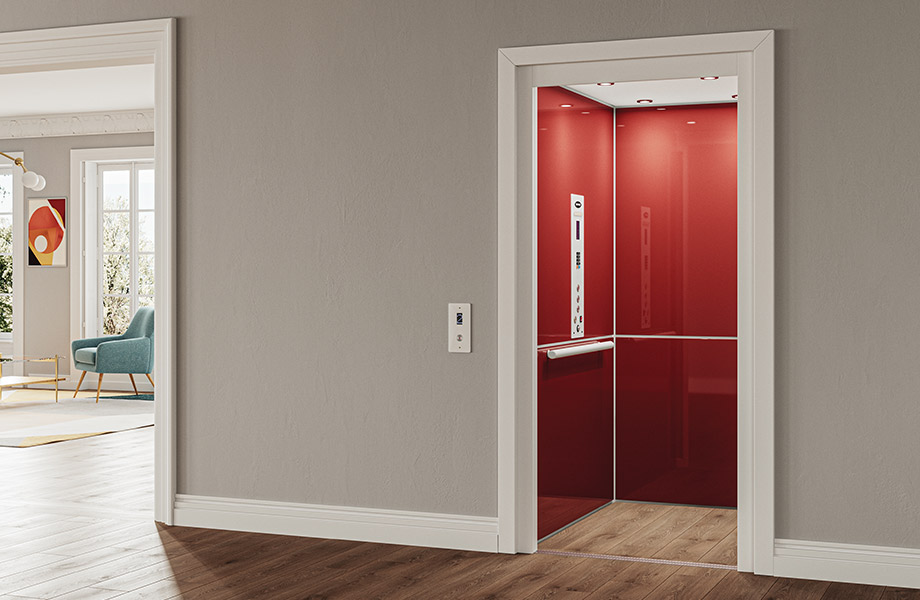Toll Free: 1.888.333.5023
Menu
How much do home elevators cost? How does a through-the-floor lift work? Is there funding available for residential ceiling lifts?
Find answers to these and other frequently asked questions about home elevators, through-floor lifts and patient care products.
Can’t find the answer you’re looking for? Contact us to get connected with your local Savaria Home Access expert.

Home elevators are specialized versions of commercial elevators that meet code requirements for travel distance, speed, size, and capacity for use in a private residence. Most home elevators require a shaftway or hoistway, but there are certain exceptions like the Savaria Vuelift panoramic glass home elevator.
Prices vary considerably depending on the model selected and optional features such as custom finishes, door options, and travel distance/number of stops. Savaria offers a full lineup of customizable home elevators from basic to luxury options. Get in touch with a Savaria Home Access expert for an accurate quote today.
Home elevators feature automatic operation, which means they move automatically with the touch of a button. Wheelchair lifts feature constant pressure operation, meaning a button must be held down continuously for the lift to move. While some manufacturers may call their product a ‘wheelchair elevator,’ if you need to press and hold the button to make the platform or cab move up or down, it is technically a wheelchair lift. Some residential wheelchair lifts like the Savaria Telecab look very similar to a traditional home elevator, but do not require shaftway construction.
A home elevator is a luxury convenience feature that may increase your property value. From transporting bulky or awkward items like laundry from one level to another, to making plans for aging in place—or in some cases adding a stand-out design feature to the home—there are many reasons why a potential buyer may desire a home that includes a residential elevator.
Savaria home elevators feature a wide selection of finishes and fixtures with your choice of drive system. Talk to a Savaria Home Access expert to find the right elevator for your lifestyle and interior space.
Every Savaria home elevator is fully compliant with ASME A17.1/CSA B44 Safety Code Section 5.3 – Private Residential Elevators, which outlines the criteria that must be met to avoid deflection, entrapment, and other safety risks. Our home elevators are engineered and manufactured to the same quality standards as our commercial accessibility lifts. Safety features include emergency lowering, a telephone, elevator door interlocks, an overspeed braking system, and an emergency stop button. Your local Savaria Home Access expert can help guide you through any additional code, permitting and inspection requirements in your area. Get in touch with your local Savaria dealer to get started.
The best home elevator is the one that suits your needs, your home and your lifestyle. There are many factors to consider including space requirements, design preferences, and cost. Your local Savaria Home Access expert can conduct a free assessment and help you select a model from our extensive range. You can also have fun building your own home elevator cab with the online configurator on Savaria.com.
In most jurisdictions, home elevators are regulated devices that require a certified elevator technician to install and service them. Do not attempt to install or service a home elevator yourself, no matter how handy you might be! First, doing so can result in severe injury and even death. As a result, no reputable elevator manufacturer will sell their products directly to consumers to install on their own. Second, DIY home elevators and DIY maintenance or repairs will likely not be covered by manufacturer warranty, and may also adversely impact or even invalidate your home insurance.
Most private insurance providers will not cover the cost of home elevators. Check with your provider about your specific policy.
Home elevators are not covered under Medicare since they are considered home modifications instead of durable medical equipment (DME).
Many local and federal funding programs consider home elevators as home modifications rather than medical equipment. However, a home renovation funding program or tax credit may be available in your region. As well, there may be financing options including adding your home elevator to your mortgage. Contact your local Savaria Home Access expert to learn about funding options.
It is usually possible to install a home elevator in an existing home. You must consider the dimensions of the model, as well as the hoistway, machine room (if required), overhead requirements (at the top of the elevator), and pit requirements (below the elevator). If your home was not built with a ready-made shaftway, you will need to have one built prior to the elevator being installed. The Savaria Vuelift panoramic home elevator includes its own integrated hoistway, so it offers more floorplan flexibility and does not require the additional construction involved in building an elevator shaft hoistway. You might also consider a through-the-floor lift, which also does not require hoistway construction. Learn more about retrofit solutions from your local Savaria Home Access expert.
The minimum space requirement for a home elevator will vary depending on the model, cab size, and whether a hoistway or machine room are required. For instance, the machine roomless Savaria Vuelift panoramic home elevator that includes its own integrated hoistway can have a footprint as small as 50-inches.
For two-stop, space-saving accessibility, a through-the-floor lift is often a cost-effective alternative to a home elevator. No hoistway is required since this type of lift features a floor cut-out and enclosed drive tower attached to a support wall. However, through-the-floor lifts use constant pressure operation, so a button must be pressed down continuously to move the lift. This type of lift is designed for someone who uses a mobility device or wheelchair. Learn more about the Savaria Telecab.
The minimum space requirement for a through-the-floor lift will vary by model and cab size. The original Savaria Telecab requires a minimum floor cut-out of only 36″x60.5″.
No. The Savaria Telecab features special sensors that will detect the obstruction and prevent the lift from travelling to the upper floor.
Because a through-the-floor lift is technically a wheelchair lift, there may be local, state/provincial and federal funding programs in your area to help you save money. Depending on your jurisdiction, there may also be tax incentives to purchase a home wheelchair lift. For example, Savaria Telecab models are zero-rated HST/GST in Canada. Your Savaria Home Access expert can help guide you through local funding questions.
Some manufacturers refer to their through-the-floor lift products as wheelchair elevators. But any product that operates with constant-pressure controls—you have to press and hold the buttons to make the platform or cab move up and down—is technically a wheelchair lift and not an elevator. All elevators operate on automatic controls—you press the button for the floor you want and the cab automatically takes you there. Some residential wheelchair lifts may be installed outside (depending on the model), while home elevators are for indoor use only. No matter your choice, we offer a full range of residential wheelchair lifts and home elevators to suit your unique needs.
A ceiling lift transports a user in a sling attached to an overhead track. This track may be attached to the ceiling or self-standing. Ceiling lifts are common in hospital long-term care settings but some models are available for home use. They require assistance from a caregiver to help the user enter the lift and to operate it safely.
We offer a full line-up of portable and fixed ceiling lifts, mobile sit-to-stand lifts, slings, transfer aids, and more.
A ceiling lift can be used to transfer an individual with advanced mobility challenges. Simpler ceiling lift systems use a gantry installed above the bed and are typically used to transfer a patient from their bed to a wheelchair. More complex ceiling lift systems can travel from room to room along a track installed in the ceiling, such as from the bedroom to bathroom. With the Savaria FastTrack system, we can configure custom fixed track in modular sections for straight runs, curves, and room-covering designs.
To operate a ceiling lift, the caregiver must transfer the user into the sling, attach the sling to clips, and then operate the lift either by hand or using powered operation. Learn more about Savaria ceiling lifts.
Ceiling lift costs can vary significantly, depending on models and factors like how much track is needed, and the type of ceiling in your home. For the most accurate pricing information, consult with your local authorized Savaria Home Access dealer.
Your loved one’s healthcare provider or Occupational Therapist can instruct you on proper sling use. This may vary depending on individual needs. A basic, universal sling can work for many users in a range of sizes. However, there are specialized types of slings that require separate instruction such as hygienic slings for toilet use, and repositioning slings for moving someone in bed. Your Savaria Home Access expert can work with your Occupational Therapist to help select the right sling for your loved one.
Depending on your jurisdiction, you may be able to get funding for a ceiling lift through local, state/provincial and national programs. Get in touch with your local Savaria Home Access expert to learn more about local and national funding programs.
One of the main concerns about ceiling lifts is that traditional inward hinging clips are easy to push, so the caregiver may think the sling is attached to the lift when it is not. The Savaria SureClip system solves this dilemma since it secures the sling by hinging outwards. This simple design detail helps reduce the risk of improper use, and therefore helps to prevent falls and other mishaps.
To ensure safe installation, always use a factory-approved technician. It is important that your installer performs a load test as the last step of the installation to make sure the system can carry the maximum rated capacity on the ceiling lift. For a fixed track system, it’s important to evaluate whether your ceiling needs reinforcement for safe use. Your local Savaria Home Access expert can get you in touch with a qualified installer.
Didn’t find the answer you were looking for? Complete the form to get in touch.

We’re all about better mobility for life. As a global leader in accessibility, we make products to help people maintain their personal mobility and independence. Your local Savaria Home Access expert would be delighted to conduct a free assessment to help you select the best products for your needs.
© Copyright 2024 Savaria. All rights reserved.
Privacy Policy | Cookie Policy
QUICK LINKS
GET IN TOUCH
Toll Free:
1.888.333.5023
homeaccess@savaria.com
Outside North America:
1.905.799.5519
10888 Metro Court
St. Louis MO 63043 USA
is part of Savaria Corporation